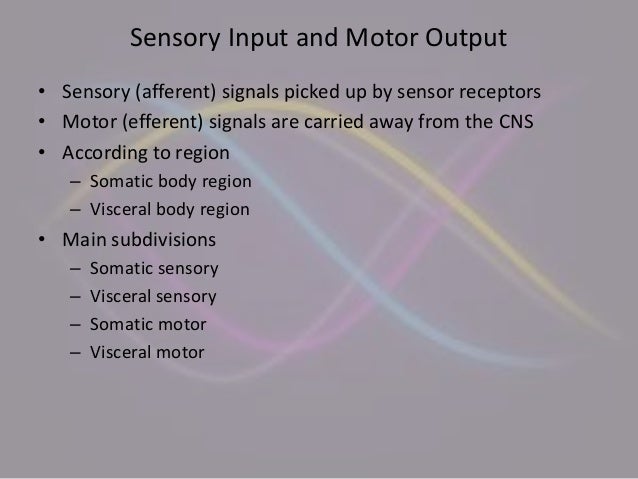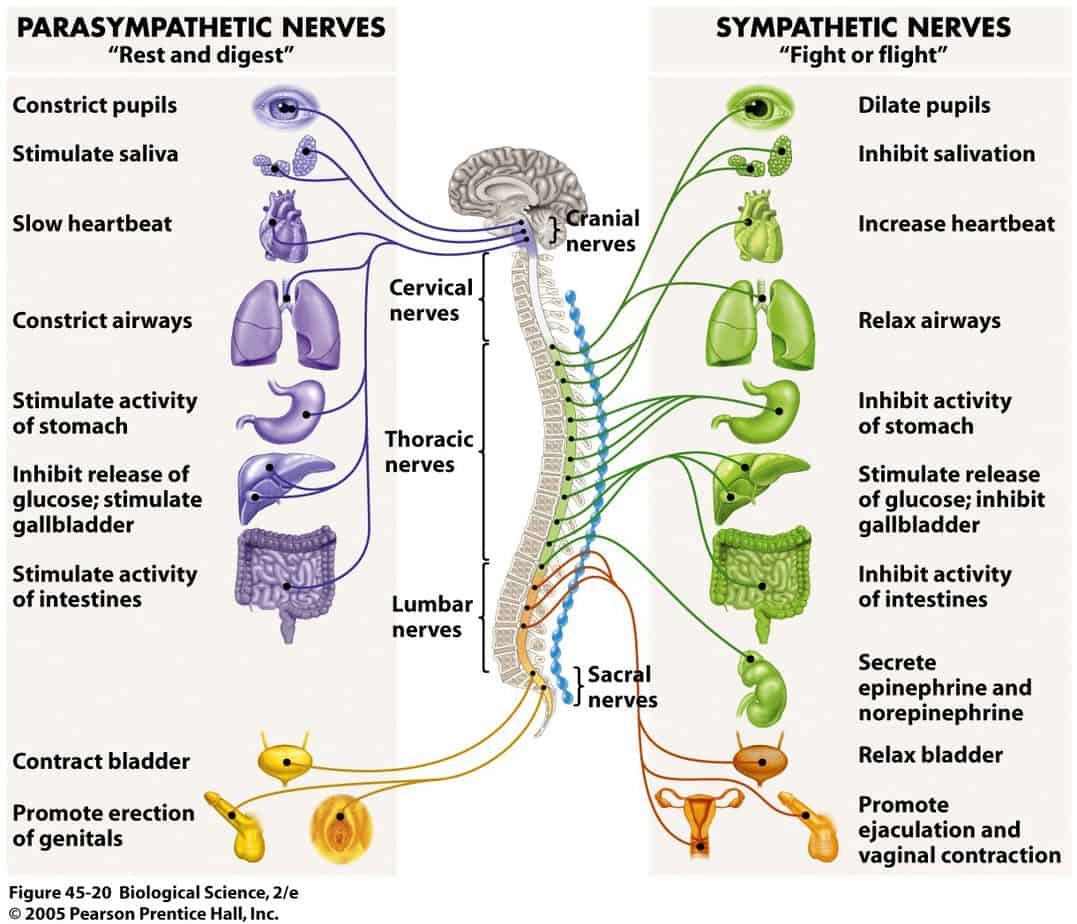The nervous system
- Created by: Charlotte170289
- Created on: 11-01-21 12:59
The nervous system
The nervous system detects and responds to changes inside and outside the body. Together with the endocrine system, it coordinates and controls vital aspects of body function and maintain homeostasis. To this end the nervous system provides an immediate response while endocrine activity is usually, slower and more prolonged.
The central nervous system (CNS) consists of:
- The brain
- Spinal cord
The peripheral nervous system (PNS) consits of:
- All the nerves outside the brain and spinal cord, neural tissues in the body, cranial, spinal and peripheral nerves.
The nervous system has 3 broad functions:
- Sensory input
- Information processing (intergration)
- Motor output
Neurons
There are two types of nervous tissue: Neurones and Neuroglia
- Neurones- (nerve cells) are the working units of the nervous system that generate and transmit nerve impulses. Neurons are supported by connective tissue, collectively known as Neuroglia, which formed from different types of glial cell. There are vast numbers of both cell types:
- 1 trillion Glial cells, 10 times fewer neurones.
Each neurones consists of a cell body and its processes: 1 axon and, usually many dendrites.
Neurones are commenly referred to as nerve cells. Bundles of axons bound together are called nerves. Neurones cannot divide and for survival they need a continuous supply of exygen and glucose. Unlike many other cells, neurones can normally synthesise chemical energy (adenosine triphosphate, or ATP) only from glucose.
Neurones generate and transmit electrical impulses called action potentials. The initial strength of the action potential is maintained throughout the length of the neurone. Some neurones initiate action potentials while others act as relay stations where they are passed in and sometimes redirected. They create the neural pathway that connects the body, spinal cord and the brain. Neurons connect to each other and with body tissues such as skeletal muscle at synapses.
Actions potentials can be initiated in response to stimuli from: Outside the body e.g. touch, light waves and Inside the body e.g. a change in concentration of carbon dioxide in the blood alters respiration
Neuron
Parts of a neuron
- Dendrite- receive stimulus and carries the nerve impulses toward the cell body.
- Cell body- nucleus and cytoplasm
- Axon- fibre which carries impulses away from the cell body
- Schwann cells- these are cells found on axon of myelinated neurons that produce myelin in the peripheral nervous system
- Myelin- this forms a sheath around the axon and is a dense lipid (Fatty) later, it insulates the axon and helps speed up the transmission of the nervous impulses alon ghr axon.
- Node of Ranvier- gaps in the myelin sheath, they help to speed up the transmission of nerve impulses as the impulse jumps from gap to gap
- Impulses always travel from dendrites towards the cell body to axon, regardless of whether they are taking messages from the body to the nervous system (afferent or sensory neurons) or from the nervous system to the body (efferent to motor neurons)
Neurons
- Afferent neurons (sensory neurons); transmit snesory signals to the central nervous system from receptors in the body.
- Efferent neurons (motor neurons): transmit signals from the central nervous system to effectors in the body such as muscles and glands
- Interneurons: form complex networks within the central nervous system to intergrate the information received from the afferent neurons and to direct the function of the body through efferent neurons
Synapse
- Synapse: is the small gap or space between the axon of one neuron and the dendrite of another
- It is the junction between neurons which uses neurotransmitters to start the impulse in the second neuron or an effector (muscle or gland)
- The synapse insures one- way transmission of impulses
- The neurotransmitter corsses the synapse and stimulates an impulse in the post-synaptic membrane
- Neurotransmitters are a group of chemical agents released by neurons (nerve cells) to stimulate neighboring neurons or muxcle or gland cells, thus allowing impulses to be passed from one cell to the next throughout the nervous system
Synapse

Central nervous system (CNS)
Consists of the brain and the spinal cord:
- The spinal cord -carries sensory and motor information between the brain and most other parts of the body. To carry out this function the spinal cord is the origin of many spinal nerves, which allow communication with the peripheral organs. The neural tissue is encased within the spine which runs from the medulla to the level of the first or second lumbar vertebrae.
- The brain processes the sensory information- organising it and making sense of it (integration) and generates moror instructions.
Central nervous system (CNS)
The brain
The brain is made up of:
- The cerebrum (left and right hemispheres) that are divided up into different lobes
- The Cerebellum
- The brain stem (midbrain, pons and medulla oblongata)

Different parts and functions

Regions of the brain
- Cerebrum- conscious activity including perception, emotion, thought and planning
- Thalamus- Filters and relays information to various brain regions
- Hypothalamus- Involved in regulating activities internal organs, monitioring information from the autonomic nervous system, controlling the pituitary gland and its hormones, and regulating sleep and appetite.
- Brainstem- medulla, pons and midbrain (involuntary response such as the heart rate, respiration and consciousness) and relays information from the spine to the upper brain.
- Cerebellum- coordination of movement and aspects of motor learning.
Cerebrum

Peripheral nervous system (PNS)
The peripheral nervous system:
Transmits sensory information from the body- sensory organs, skin, skeletal muscles, joints and visceral organs- to the CNS (sensory input = Afferent)
Transmits motor instructions from the CNS to organs/ muscles (motor output = Efferent)
The peripheral nervous system (PNS) is the division of the nervous system containing all the nerves that lie outside of the central nervous system (CNS). The primary role of the PNS is to connect the CNS to the organs, limbs, and skin. These nerves extend from the central nervous system to the outermost areas of the body. The peripheral system allows the brain and spinal cord to receive and send information to other areas of the body, which allows us to react to stimuli in our environment.
.
Peripheral nervous system (PNS)

Sensory input (afferent)
- Sight
- Hearing
- Balance
- Touch
- Taste
- Smell
- Pressure
- Heat
- Proprioception (position and movement of the body)
Thalamus
- All sensory information, except smell, passes into the Thalamus in the brain.
- The thalamus does some filtering of the sensory information it receives so that the important information is passed on to the right bit of the cerebral cortex for processing
- Motor instructions coming from the cerebral cortex do not go via the thalamus but direct to the spinal cord.
- At the same time the thalamus sends a signal to the cerebral cortex it also sends a signal to the Amygdala that are part of the limbic system that deals with emotion and memory.
- The amygdala help process emotions/ aggression and flight, freeze or fight responses
- The amygdalas reaction is quicker than the cortex and so we act on our emotions before our thinking brain has chance to work out what is best to do
Thalamus

Motor output- efferent part of PNS
The motor output or efferent part of the PNS is divided into:
- The somatic nervous system (conscious/ voluntary skeletal muscle control and reflex actions)
- The Autonomic nervous system (automatic/ involuntary muscle control- viscera, cardiac muscle, glands) which is further divided into the :Sympathetic nerves and Parasympathetic nerves

Somatic nervous system
The somatic nervous system:
- Sensory information is processed by the brain and we can then choose an action e.g. to walk or life an object
- Reflex- a reflex is an involuntary response to a sensory stimulus and the motor instructions comes from the spindal cord (right side of the cord controls the right side of the body)
Autonomic nervous system
- Sympathetic nerves- fight or flight - it is responsible for preparing your body for physical and mental acitivity.
- Parasympathetic nerves- rest and digest- it is responsible for bodily functions at rest.

Human nervous system
Consists of:
The central nervous system (CNS)- brain and spinal cord
Peripheral nervous system (PNS)- cranial, spinal and peripheral nerves containing:
Somatic voluntary motor responses and reflexes
autonomic involuntary motor responses Containing:
parasympatheric- rest and digests
sympathetic- fight, flight, freeze
Summary of nervous system
- 3 functions - Sensory input, information processing, motor output
- CNS = brain (cerebrum, cerebellum, brain stem) & spinal cord
- PNS = cranial, spinal and peripheral nerves,
- PNS = somatic (voluntary) & autonomic (involuntary)
- Autonomic = sympathetic (fight & flight) and parasympathetic (rest and digest)
- Nerve cells = neurons, electrical nerve impulses, synapses
- Sensory input (afferent) includes – Sight, Hearing, Balance, Touch, Taste, Smell, Pressure, Heat, Proprioception
- Sensory information via thalamus (except smell) to cerebral cortex for processing (integration)
- Motor instructions (efferent) from cerebral cortex direct to spinal cord (not via thalamus)
- Left side of cerebral cortex controls right side of body and vice versa
- Reflex = involuntary & motor instruction comes from the spinal cord
- It controls and coordinates all essential functions of the body including all other body systems allowing the body to maintain homeostasis
Related discussions on The Student Room
- Bradford university nursing interview »
- How hard is Children Nursing? »
- Oxford Brookes Nursing 2023-2026 »
- UWE Health Professions Foundation Course 2022 »
- Bradford University nursing 2022 »
- BNU Midwifery interview »
- Wolverhampton University Adult Nursing interview help. »
- OSCE advice »
- Adult and Mental health Nursing at Anglia Ruskin University 2023 »
- Nursing interview at RGU Aberdeenn? »
Comments
No comments have yet been made